

| The Hornet in Nottinghamshire | ||
| By any standards, the
Hornet (Vespa crabro) is one of our most
impressive and imposing insects and people with a great
fear of Wasps, certainly have a fear of Hornets when they
see one. Yet although Hornets can deliver a painful sting, it is said by those who have experience, to be no worse than the sting of a Common Wasp. Most people will agree, that it was their own fault that led to them being stung. Like Wasps, Hornets will only sting when they, or their nest is threatened. Despite their notoriety and more menacing 'buzz' in flight, Hornets are actually docile insects. Avoid the flight line of workers to and from any nest and it is possible to watch them for hours unharmed. Worker Hornets have a length of around 2.5cm, which means it is by far the largest species of wasp found in the UK. |
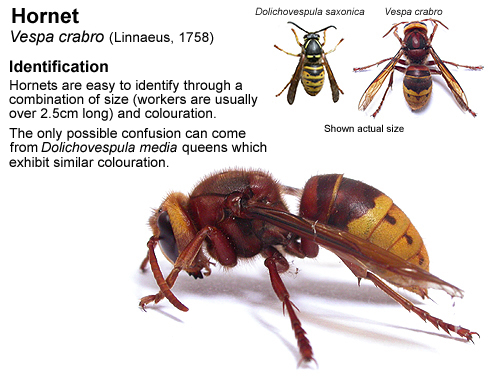 |
|
| ... | ||
| They are terrific predators, taking a wide range of invertebrate prey items which are usually snatched from foliage or flowers. During the Autumn months when the colony is breaking up, they will visit Ivy blossom for nectar. Workers can forage at night when moonlight allows, so they regularly turn up at light traps operated by moth trappers. | ||
| ... | ||
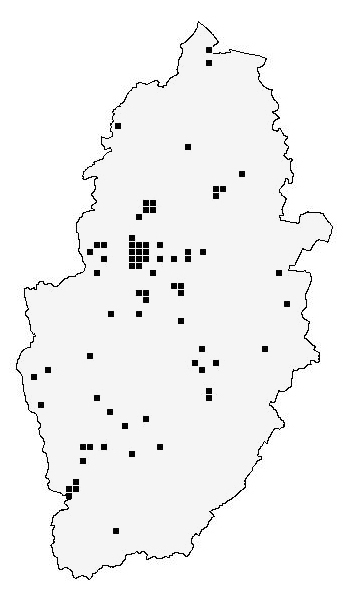 |
Nottinghamshire
distribution Although still generally an uncommon insect, the Hornet is perhaps more widespread in Nottinghamshire than the lack of records east of the River Trent would indicate. Records on the accompanying distribution map range from Attenborough NR in the south, to Dyscarr Wood in the north. The Sherwood Forest area, probably offers the best chance for people purposefully wishing to see one, but there are records from suburban Nottingham. In the 1980's I found a Hornet nest on Nottingham Arboretum, which at the time was believed to be the most northerly UK record. Since the 1980's, there has been an increase in range following a succession of milder Winters. Hornet nests Colonies build up during the Summer and can eventually total several thousand workers by the time the colony dies at the onset of cold weather. Only the young queens survive the Winter, hibernating in sheds and hollow trees etc, to start new colonies the following Spring. Nests are usually found within dead or decaying trees, but roof spaces, nesting boxes and any suitable dry space will be utilised. A few years ago, we located an active Hornet nest, located within a hollow tree at Lound Wood near Eakring. The entrance hole to this nest was small (about 2.5cm) and closer inspection revealed that it had been made smaller by the workers. Workers were observed arriving at the nest at a rate of about one every two minutes, so the colony held quite a large population at its peak of activity. By mid-October, the daily temperature was low enough to enable a closer (and safe) inspection of the nest cavity. Worker activity was by then confined to just one or two sluggish individuals, that remained faithful to the largely deserted nest. |
|
| ... | ||
| Below and to the right of the nest entrance, the tree was completely hollow and the actual nest was clearly visible. The whole nest was constructed by the workers from chewed wood, mixed with saliva to form a pulp. Different sources/types of wood used in the nest construction, can be seen as "strata" within the hexagonal-shaped cells. | ||
| ... | ||
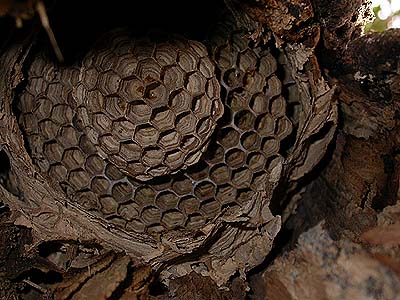 |
The layers of cells were
typically arranged, each new layer being suspended from
the previous layer, by a thick central support - with the
nest increasing in size as the population grows
throughout the Summer months. The lower (newest) layer,
is the smallest and readily visble in the photograph. Several outer layers enclosed the nest. These afforded added protection to the brood cells from the elements and allowed the workers to control nest temperature. How safe are Hornets? The presence of Wasp and Hornet nests in or near buildings, is often a cause of concern to the public. However, unless the nest entrance is situated close to a door or a regularly opened window, they are perfectly safe to leave in place. |
|
| ... | ||
| Obstructing the flight path used by foraging workers to and from the nest, will probably trigger an unwelcome response if you stand and wave your arms about, but generally both Wasps and Hornets will only sting when directly threatened. Remember that these are important insects, taking huge numbers of insect pests from gardens over the course of a Summer. | ||
| ... | ||
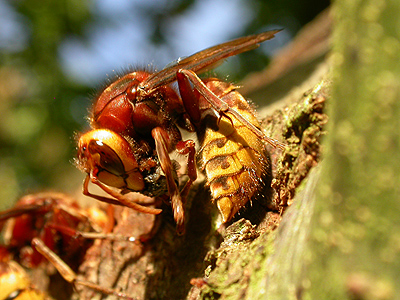 |
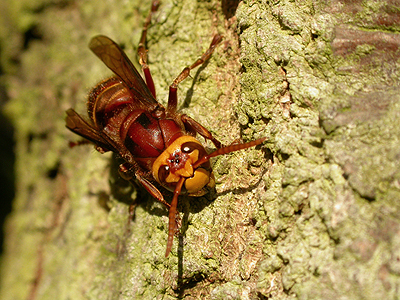 |
|